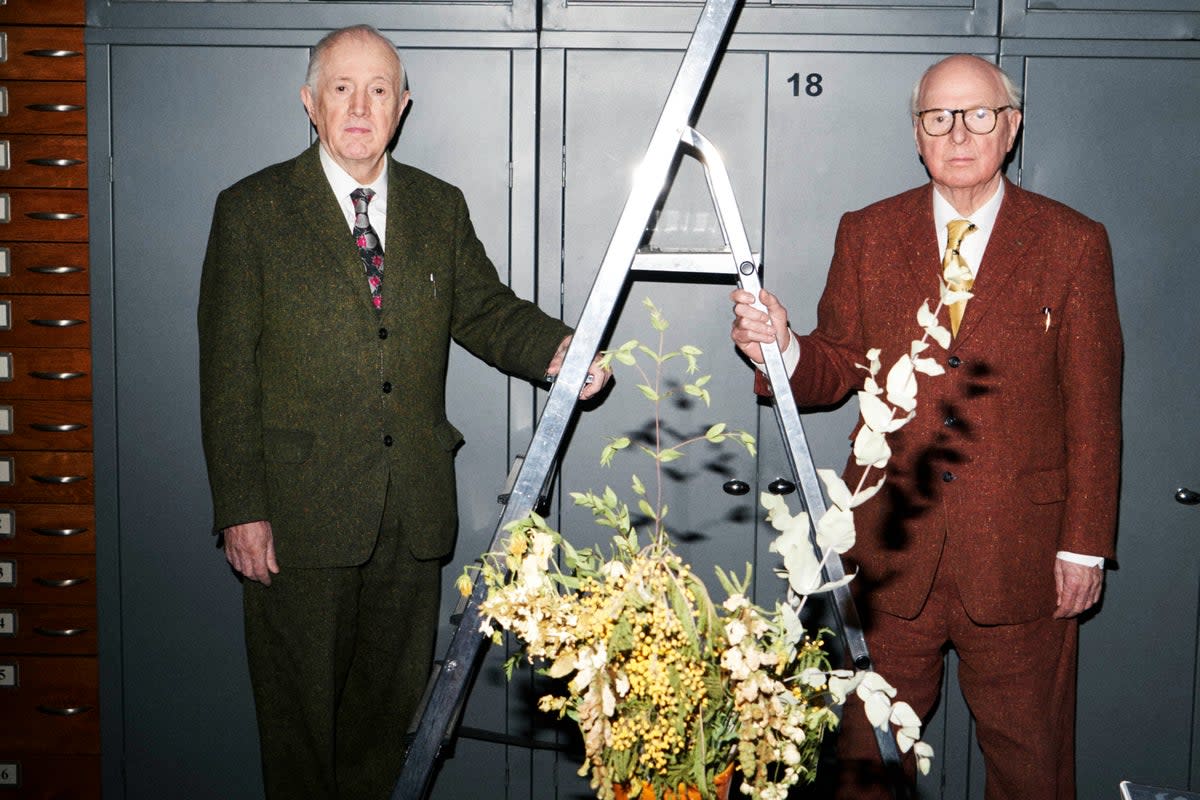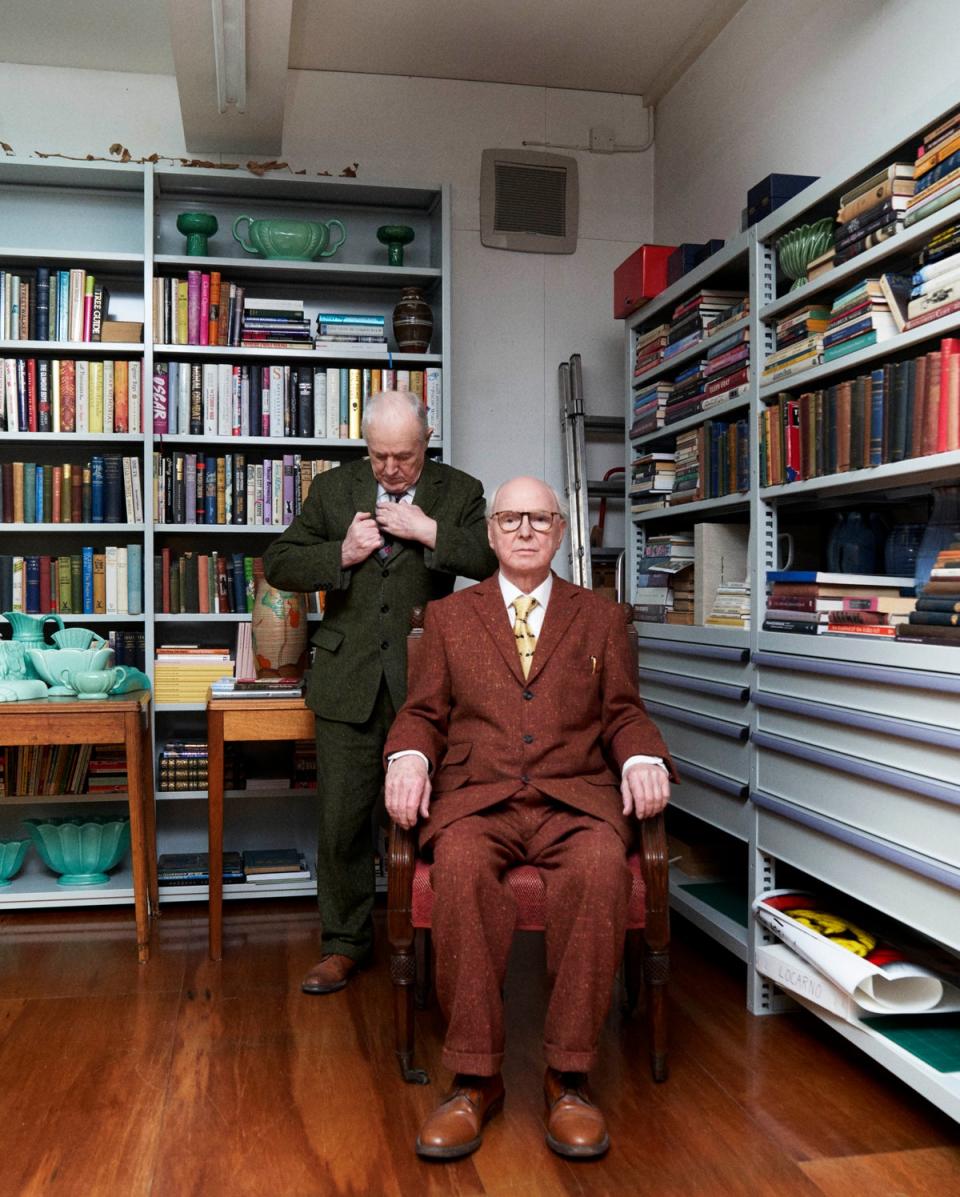Gilbert & George: ‘London felt like the centre of the universe’

It’s one of those early spring mornings where the sun is peeking through the clouds and nobody besides the weatherman can tell whether you’ll be absolutely freezing or perspiring beneath your coat. It transpires that today is most certainly the latter, but either way, standing outside a pair of great, vibrant green gates on Heneage Street in east London, Gilbert Prousch, 79, and George Passmore, 81, are in their trademark get-up: a pair of dashing, three-piece tweed suits. Across the road, a blonde woman is asking a man at the door of an Afro hairdresser why she can’t get her hair cut; there are builders buzzing around us nodding ‘alright, mate?’ at either Gilbert or George; and a van parked a few doors up is being filled with a household’s worldly possessions. ‘It looks like someone is moving,’ observes Gilbert.
The reason we’re here? Behind the elaborate green gates, hallmarked with two winding Gs and topped with King Charles’ royal crest, is The Gilbert & George Centre, a permanent celebration of the two artists’ 56-year career and the distinctive, daring work that made it. Complete with three galleries, a screening room, and a beloved Himalayan magnolia tree dedicated to their late friend and curator Ron Brownson, the centre is set to open to the public on 1 April, and feature an array of changing exhibitions intended to carry on their legacy and immortalise the pair long after they’ve checked out.

Our interview is due to take place a few streets away at their home and studio on Fournier Street, and as we amble there, the pair reminisce about how much the street has changed since they moved here in 1968. ‘We were the only artists and everybody was amazed that we would live here. It is quite romantic and at the same time they felt it was quite dangerous,’ says Gilbert. ‘Cab drivers would say, “When’s this lot coming down then?”’ adds George. ‘Not “will it come down?”, just “when?”’ Today the residential Georgian street is one of the most desirable in town, a far cry from the area which inspired the artwork that shot the two to global fame, when back in 1969 the pair came across a copy of the song ‘Underneath the Arches’ by Flanagan and Allen in a second-hand shop. ‘We didn’t know what [the title] meant except that we were living in the East End where there were thousands of people living underneath the arches and in hostels,’ says George. ‘The vast majority were ex-service-men and there were quite a big percentage damaged by the sex laws before decriminalisation — at least a third were damaged from being put in prison for [homosexual] sex. It contained all of the thoughts and feelings that were relevant.’
We used to go clubbing at Blitz. We used to be there every night
The song became the basis of their piece, The Singing Sculpture, which they’d end up singing (‘It’s not a performance; performance art is art that alienates most people,’ quips George) with their hands and heads painted silver all over the world. ‘It’s still relevant. All of these people have gone, they’ve all died. They have been replaced by a smaller group, a younger group of drug addicts, of course. Equally dispossessed and equally enchanting in their own way.’
Needless to say, with around 120 collective years roaming this city under their belts, that’s not the only change they’ve seen. ‘London was a very different place then from what it is now. And the world is a very different place from 1967 [when the pair met at what is now Central St Martins],’ says Gilbert. ‘It’s difficult to imagine how privileged we were at that time.’
George continues. ‘London was extraordinarily famous in a different way from now. Not more or less, just different. The Beatles were out and The Rolling Stones. Covent Garden was completely deserted but very trendy. It was extraordinary. There were people from countries of the world that I’d never heard of, filming in Saint Martin’s School of Art. We felt we were living in the centre of the universe. The Charing Cross Road was world famous, even more so than now.’ And a stone’s throw away is where you’d find them, says Gilbert. ‘We used to go out clubbing, not in the East End, but at the Blitz. We used to be there every night. You know, misbehaving, coming back in a cab.’
In the vast studio at the back of their home the pair show me the archive of invitations to all of their shows. One, an early set of multicoloured flyers, handwritten in swirly letters, catches my eye. ‘This was for different groups playing, and at that time we didn’t know if we wanted to become musicians or artists,’ says Gilbert. ‘We printed these out in a photocopy shop, handed them out ourselves at Liverpool Street Station. Nobody came, of course,’ adds George. Though that didn’t stop them. Driven by belief in their work, they took their act to the public.
‘In the late 1960s we did a Rolling Stones concert. Not for the concert, we didn’t actually see the concert. We went because we knew that we would have an amazing public,’ George continues. ‘And as we went through the park as living sculptures, all of the young people came up to us asking extraordinary, intense personal questions as though we would know the answers to life itself. It was such a free time. I remember a lot of people were wearing kaftans. They were sitting in the park with their knees up underneath the kaftan, masturbating, clearly… because it was free love. Anything goes was the term. Nobody batted an eyelid. Now it would be more difficult…’ ‘Now you would have to do it in prison,’ chimes Gilbert.
These days, you won’t find them hanging out in the park, though they are still creatures of habit in other ways, especially when it comes to food. With no kitchen, they dine out every night. ‘We went to Mangal 2 every night for 25 years and then one night we saw somebody putting a cable around the room. We said, “What’s that for?” They said they’re putting in a music system. So now we go to Mangal 1,’ says Gilbert. ‘We’re heading for Mangal 0,’ he jokes. ‘The staff are so friendly and so nice. They’re a real family. We have our table that’s reserved for us every night, against the wall, near the column.’ George adds: ‘We have a view of the boys in the kitchen to keep an eye on things.’
At more than half a century together and still going strong, it seems perhaps the key to a happy partnership might be to nix the kitchen. But, seriously, what is the secret? I ask. To which Gilbert replies: ‘We want to win with our art, with our vision. That is driving us day and night. We never stopped that.’ And despite the fact their most recent works, unveiled at the White Cube earlier this week, are titled The Corpsing Pictures, it seems these two have no intention of slowing down just yet.
The Paradisical Pictures’, the inaugural exhibition at The Gilbert & George Centre, opens 1 Apr (gilbertandgeorgecentre.org). ‘The Corpsing Pictures’, until 20 May at White Cube Mason’s Yard (whitecube.com)


